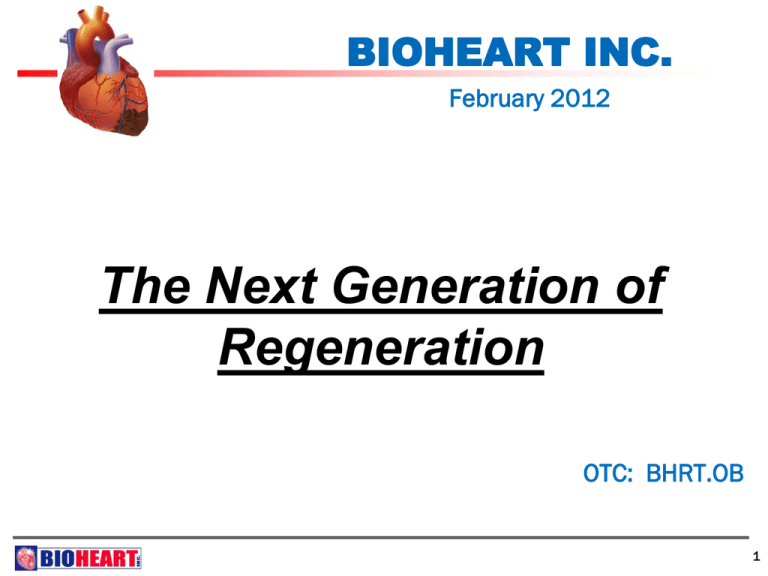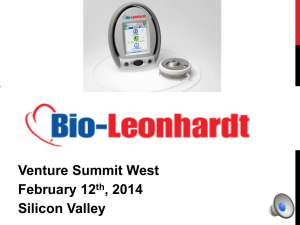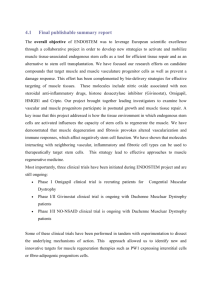Bioheart, Inc - Leonhardt Ventures
advertisement

BIOHEART INC. February 2012 The Next Generation of Regeneration OTC: BHRT.OB 1 Forward-Looking Statement Except for historical matters contained herein, statements made in this presentation are forward-looking and are made pursuant to the safe harbor provisions of the Private Securities Litigation Reform Act of 1995. Without limiting the generality of the foregoing, words such as “may”, “will”, “to”, “plan”, “expect”, “believe”, “anticipate”, “intend”, “could”, “would”, “estimate”, or “continue” or the negative other variations thereof or comparable terminology are intended to identify forward-looking statements. Investors and others are cautioned that a variety of factors, including certain risks, may affect our business and cause actual results to differ materially from those set forth in the forward-looking statements. These risk factors include, without limitation, (i) our ability to obtain additional financing; (ii) our ability to control and reduce our expenses; (iii) our ability to establish a distribution network for and commence distribution of certain products for which we have acquired distribution rights; (iv) our ability to timely and successfully complete our clinical trials; (v) the occurrence of any unacceptable side effects during or after preclinical and clinical testing of our product candidates; (vi) the timing of and our ability to obtain and maintain regulatory approvals for our product candidates; (vii) our dependence on the success of our lead product candidate; (viii) our inability to predict the extent of our future losses or if or when we will become profitable; (ix) our ability to protect our intellectual property rights; and (x) intense competition. The Company is also subject to the risks and uncertainties described in its filings with the Securities and Exchange Commission, including the section entitled "Risk Factors" in its Annual Report on Form 10-K for the year ended December 31, 2009, and its Quarterly Report on Form 10-Q for the quarter ended June 30, 2010. 2 MyoCell® Cell Therapy Overview Muscle stem cell-based therapy designed to treat heart damage by growing new muscle in damaged heart tissue. Uses myoblasts (muscle stem cells) • Patient-derived; reduces risk of tissue rejection • Committed to forming muscle, will not differentiate into other cell types or over-proliferate • Tolerates low-oxygen conditions present in scar tissue Large potential savings in healthcare costs 3 Myoblast Transplantation Data Summary • • • • • • • • Dr. Race Kao 1988 The Physiologist canine study. Dr. Doris Taylor 1998 Nature Medicine rabbit study. Dr. Philipe Menasche June 2000 first surgical case LANCET. Dr. Patrick Serruys May 2001 first cath case JACC. 350 patients in clinical trials to date. 84% cell treated patients improved. Only 16% worsened. In comparison 69% of control pts on CHF drugs worsen. Phase II/III double blinded, randomized, placebo controlled results just published in American Heart Journal. Bioheart MyoCell patients 95.7 meters improvement in exercise capacity over placebo (-4) patients. End point goal was 16 meters. Beat primary end point goal by over 500%. 4 Myoblast Engraftment Post-Transplantation Human Heart, Proof of Concept Contractile muscle tissue growing in the scarred portion of the heart following treatment with myoblast injections. * Hagege et al., Viability and Differentiation of Autologous Skeletal Myoblast Grafts in Ischemic Cardiomyopathy, Lancet, Vol. 361, 2003: 491-492 5 MyoCell: Heart Failure Treatment Process 2 Cell manufacturing following thigh muscle biopsy Injection of skeletal myoblasts into scar tissue using deflecting-tip catheter 3 1 Scar tissue following heart attack 6 Competition Bioheart’s technology is the most advanced and effective of all cell therapies for CHF. Bioheart has Intellectual Property and technological exclusivity that protects freedom of operation. Myoblasts have been shown to be the only effective cell-based therapy to grow new contractile muscle (myogenesis) in true scar tissue for treatment of CHF. Adipose (fat) derived stem cells are preferable over bone marrow stem cells in indications requiring angiogenesis, because they are autologous, easy to obtain and abundant. 7 Bioheart Has Addressed CHF with Myocell Trial EU Phase I/II MYOHEART (US, Phase I) SEISMIC (EU, Phase II-a with Control) MARVEL Trial (N. Am./EU: Phase II/III, Double-blind, Placebo-controlled) # of Patients Status 5 Phase I 15 Phase I/II Completed Q2 2003 20 Completed Final Patient Treated Q4 2006 40 (14 control) Completed Final Patient Treated Q3 2007 160 anticipated (50 controls) Part 1 Results Published, Part II launching now Primary Endpoints • Serious adverse events • Global ventricular function • Serious adverse events • Serious adverse events • LVEF • Serious adverse events • 6-minute walk test • Quality of life score Including third-party studies, myoblasts have been evaluated in at least 12 clinical trials involving more than 350 patients 8 Bioheart MARVEL Program Unique Features and Goals SUBSTRATE DESIGN • Left ventricular scar 2 to prior myocardial infarction • Not suited to other stem cell products • Blinded, randomized, placebo controlled • 1st trial of catheter-based therapy ENDPOINTS • Emphasis on patient centered outcomes • Objective and subjective • Goal to fulfill criteria for clinical approval 9 MARVEL Program Study Objectives / End Points Overall objective • Assess the safety and efficacy of MyoCell® in CHF patients post myocardial infarction(s) using the MyoStar® and NOGA XP® Primary safety end point • Incidence of SAEs at 3 and 6 months post implantation. Co-Primary efficacy end point • Changes in 6-minute walk distance or quality of life. Secondary efficacy end points • Changes in LVEF, LV volume, wall motion indices, BNP, NYHA class, and frequency and nature of rehospitalizations. 10 MARVEL-1: Mean Change in 6-Minute Walk Distance (meters) p=0.50 n=6 n=7 n=6 11 MARVEL-1 Arrhythmia Analysis: Myocell® Patients Myocell® Txt 14 Patients No Amiodarone Txt n= 7 4 Patients 4 Episodes VT Amiodarone started 0 Episodes VT Amiodarone Started at Implant or Stopped n=3 2 Patients 2 Episodes VT Amiodarone Started at Bx n=4 0 Patients 0 Episodes VT Amiodarone continued 1 Patient 1 Episode VT 12 Bioheart: The FDA Approved REGEN Trial Next Generation: MyoCell® SDF-1 SDF-1 Cells Damaged area secretes chemokine proteins Increased muscle formation Adult stem cells Endogenous circulating stem cells attracted to injury by chemokine proteins Increased blood vessel supply Four years of sponsored animal studies have demonstrated that 2nd generation MyoCell ® SDF-1 provides significantly higher levels of improvement than the first generation MyoCell ® composition. 13 REGEN Trial – MyoCell SDF-1 7 years of preclinical testing in animals at both Cleveland Clinic and the University of Florida has demonstrated double the cardiac improvement over standard myoblasts. MyoCell SDF-1 54% improvement. Myoblasts unmodified 27%. Control placebo injections minus 10%. FDA clearance received for a 15 patient, 3 center Phase I study – Dose Escalation – 3 cohorts: 200 million, 400 million and 800 million cells Historic first ever FDA approval for clinical trials for a combination gene and cell therapy for a major indication of use. 14 Bioheart, Inc - MyoCath® SR-200 Injection Catheter System 15 Manufacturing MyoCell Currently at Bioheart’s Headquarters in Florida Current facility sufficient for next two years and able to be expanded Capacity • One Shift: 15 patients/month • Two Shifts: 25 patients/month • Three Shifts: 30-60 patients/month Ability to add capacity in Florida if expanded with additional suites Other Locations to be Ramped Up as OUS business grows Korea Jordan The Netherlands 16 Repeat injections even more improvement • European Heart Journal (2010) 31, 1013–1021 doi:10.1093 Repeated implantation of skeletal myoblast in a swine model of chronic myocardial infarction Felipe Prosper et al. • A significantly greater increase in the DLVEF was detected in animals that received three doses vs. a single dose of SkM. A correlation between the total number of transplanted cells and the improvement in LVEF and DLVEF was found (P , 0.05). Skeletal myoblast transplant was associated with an increase in tissue vasculogenesis and decreased fibrosis (collagen vascular fraction) and these effects were greater in animals receiving three doses of cells. 17 Repeat Injections Even More Improvement • Control placebo LVEF 40.6 down to 37.7 P value 0.880 >> Myoblast injection results… • 1 injection session LVEF 45.1 up to 56.2 P value 0.113 • 2 injection sessions LVEF 41.3 up to 56.4 P value 0.02 • 3 injection sessions LVEF 39.3 up to 65.6 P value 0.01 18 19 20 21 Bioheart TGI System Process First objective: Reduce the damage to the heart by reducing scar size. 1 2 3 Adipose cells extracted Cells processed in the hospital in less than 2 hours using the system and disposables to extract endothelial progenitor and stem cells Selected cells infused via catheter Animal test results have shown a 90% reduction in scar size. 22 Pacemaker Features: 1. Grows new blood vessels 2. Grows new muscle 3. Increases contraction strength of muscle 4. Converts pluripotent stem cells into heart muscle cells (cardiomyocytes) 5. Ensures heart remains on beat 6. Reduces the risk of sudden death 23 MyoStim Pacemaker 24 5 Sequences of MyoStim Stimulator • The MyoStim Implantable Heart Tissue Stimulator - This product is designed to improve upon current CRT/ICD pacemakers in treating patients with heart failure and arrhythmias. The stimulator runs five (5) programs in sequence; (1) The Kanno program stimulates angioenesis (new blood vessel growth). (2) The Chachques-Leonhardt program recruits stem cells to injured heart tissue areas. (3) The Leonhardt-Chachques program differentiates recruited and/or injected stem cells to beating heart muscle. (4) The Leonhardt program senses arrhythmia's-fibrillation and delivers a low voltage pulse to restart a patient's heart back to a normal beat (replaces outdated high voltage shock ICD systems). (5) The final program is a standard synchronization pacing program that double ensures that newly created muscle, in the previous scarred areas of the heart, beats in synchrony with the rest of the heart. The stimulation pulses also duly serve to increase the contraction twitch strength of the muscle to improve cardiac output. This product will require clinical trials of approximately 300 patients. Nearly half of the 30 to 50 million patients worldwide in heart failure are expected to be candidates for this product in the future. • Market: $6 billion + 25 Enhancement of Myoblast Transplantation with Electrical Stimulation Fast twitch to Slow twitch Conversion of Myoblasts No Electrical Stimulation 100% 90% 80% 99% With Electrical Stimulation 70% 60% 66% 50% 40% Based on early observations from Dr. Juan C. Chachques, MD, PhD 26 Lab Stimulator Features: 1. Doubles the production of cell cultures w/ half the amount of growth factors & media 2. Converts pluripotent stem cells to cardiomyocytes (beating heart muscle cells) 3. No use of animal based products (FDA mandate) 27 Human Cell Cultures at 3 weeks Without Stimulation With Stimulation Double The Quantity 28 28 BioPace Biological Pacemaker • Cultured sino atrial node and atrial cells pre-conditioned with electrical stimulation. • Your own natural pacemaker can out perform any battery powered pacemaker in a steel can with steel leads. • Technology has already been validated in large animal preclinical studies King et al. • 3 issued U.S. patents to Bioheart. • Schedule plan is to complete historic first clinical patient by end of next year. • Expectation is to obsolete electronic pacemakers by the end of the decade. 29





